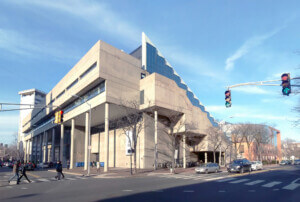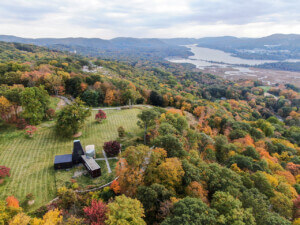In a basement laboratory at Harvard University’s Graduate School of Design, Bradley Cantrell flips a switch, and a river begins to flow. On a table surveilled by movable sensors and a Microsoft Kinect, pulses of water carry bits of colored sand down a model riverbed.
As an associate professor of Landscape Architectural Technology and director of the GSD’s Master in Landscape Architecture Program, Cantrell runs experiments like these to better understand the natural elements that make up his profession’s palette. But by using computational methods to analyze and even redesign nature, he’s also breaking new ground in the field. Cantrell’s work blurs the lines among environmental engineering, landscape architecture, and artificial intelligence. He sat down with The Architect’s Newspaper contributor Chris Bentley in April.
The Architect’s Newspaper: Your work has been described as “computational landscape architecture.” How would you define it?
Bradley Cantrell: I like the term “responsive technologies.” I use a slightly more provocative term sometimes and talk about “cyborg ecologies” or “cyborg landscapes.” It’s really that there isn’t this differentiation between natural systems and human constructed systems. Our technologies actually augment and, yes, change these, but we should celebrate that synthesis as opposed to setting up a duality. We think about nature as being bound in this one place, humans being bound in another. My take is that we should celebrate the connections between those two. It’s not my goal to put computation into everything. But my work uses computation to set up this set of interconnected relationships in a more advanced way.
You talk about embedding sensors and computational technology into the physical landscape, so the landscape reacts to its users in a kind of conversation—what are some of the possibilities of that?
We have this fluid modeling table, but we’re not really modeling a known landscape like the Mississippi Delta. What we’re really doing is using the dynamic nature of that fluid flow and looking at the way the sediment behaves within that. And we’re trying to then use ways of sensing the surface morphology so we can get a digital model of that surface. We can also get spot elevations so we understand how high places are; we can understand how fast water is moving. But then using that data, trying to imagine what are the interactions with that data in real time. We could begin to calculate the actual power of the river to build land or erase land. We could use it to stabilize certain portions, allow other portions to be more in flux.
But the idea there is that by using computation we could take on multiple goals. So it could be about building land, but also that land ebbs and flows because there’s another cycle of a bird species or something like that. Right now we’re taking a very naive approach and just saying, “What are the possibilities of how we can manipulate the system?” And then ideally beginning to layer complexity into that. Right now, when we want to change a river system, we dredge or build a levee to hold water over here and make it dry over there. So it’s a much more traditional construction method, and this one speaks to this kind of real-time interaction with the landscape.
That feedback is one that I think is really important. It speaks to the flora and fauna, too. There’s the idea of resistances among all of these different actors, that there is a form of evolution. And that leads to more resilience within that system because in some ways we’re not depending on a single moment that holds everything together.
You want to let natural systems run their full range of behaviors, but it’s risky to engineer unpredictability into our landscapes. What’s the right amount of uncertainty?
This is a really big question that I don’t have an answer to. But I think it’s a really interesting one. If you think of the way we’ve manufactured something like the Mississippi River, the current state of it has all been put into place for human beings. It’s about navigation up and down the river; it’s about protecting human settlements. And then there’s a whole series of effects from that that alter the surrounding ecosystem. But we then build other things to remediate those effects. My take would be that the relationship could just be more advanced between all of those systems. Sure, there’s going to always be these issues that pop up. But ideally the way things are being managed can propagate those changes back out to the system.
It’s not about taking all the levees down. It’s about how we’re interacting and changing the way the flow occurs in one spot, but we aggregate that off of a thousand points and suddenly the whole river system behaves slightly differently. Can we hold the river in place for a certain amount of time with some certainty? And then can we open that up and allow the river to take on a new course?
When you use terms like “cyborg coast” and “synthetic ecologies,” it sounds like you’re the Dr. Frankenstein of landscape architecture. But building responsive landscapes does not mean replacing natural systems with technology, right? What’s the ideal balance between reengineering nature and conserving it?
I think a lot of people have issues with the idea that we’re actually extending even more control over the landscape. I think there is a fear of that we’re constantly in discussion about how we relinquish control. I think it’s an open question. I would say that you do run the possibility of basically manufacturing everything. As our technologies have gotten more advanced, what we’ve seen is really having more and more control over deeper and deeper levels of biological life. Commercial agriculture is a good example of how we’ve extended that control in a way. But one of the issues there is that it all hinges on basically one variable, and that’s productivity. When everything is hinged on that, then we get a very homogenous situation across commercial agriculture. And that’s where I think this idea that there are competing goals and that humanity might not always be at the center of all of those goals—that takes somewhat of an enlightened viewpoint, but it also is one that is necessary for us to have.
Where do digital representations of the environment still come up short? Is it impossible to model a natural system without oversimplifying it?
I think there’s a kind of clarity in terms of the actual changes we’re making. It’s very difficult for me to say that when I perform this operation, it propagates up through the system in this way. It’s not all about us having better models and better simulations. Part of that is about having a clear understanding of what we’re modeling and the relationships in those models. I think that part is one that’s somewhat missing. Some of these get ironed out just by convincing someone in a small plot of land that this might be an interesting idea and going out and starting to test it.
Even an art project that takes the sediment diversion and uses it as a way to kind of print or paint the landscape—that isn’t all about exactly how the ecological system performs—may sound silly, but it’s a step in that direction. Then people start to see the potential. Building the system and letting people see how it operates is an important step—even if it’s art first.
What’s the next step in actually implementing these ideas?
All the work now is in the lab. I try to make the work a bit more robust by actually working with civil engineers, computer scientists, and ecologists to make sure that they understand that this work exists, because those conversations are the ones that become the most interesting. When an ecologist says, “I never really thought of the idea that you would create basically a robot that would create an ecological system that was outside of human construction.” Suddenly there’s a new place where, is that wilderness? Is that commercial agriculture? Is that design, when you’ve made a robot that thinks for itself and is actually changing the world around us? If we haven’t really manufactured it and it’s a place that we don’t actually understand how it completely works, because it’s this other thing making it, it’s almost wilderness on one hand. The genesis is human construction, but the actual actions are computational logics.
We’ve tried our hardest throughout time to make sure we’re not part of nature. In some ways we’re realizing that there is no separation. We’re actually remanufacturing the Earth similar to any other species that has the same capabilities we might have. That’s something for us to come to grips with. When we do, we suddenly have a new responsibility in the world. It’s not about us doing something and nature responding. What we’re doing is possibly just wrong. It’s not about responding. It’s that we need to be the ones that rethink our processes.










